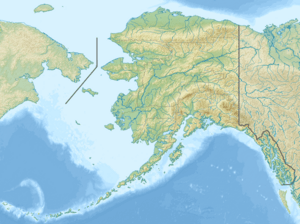Noxapaga River facts for kids
Quick facts for kids Noxapaga River |
|
|---|---|
|
Location of the mouth of the Noxapaga River in Alaska
|
|
| Country | United States |
| State | Alaska |
| District | Northwest Arctic Borough, Nome Census Area |
| Physical characteristics | |
| Main source | 9.5 miles (15.3 km) west of Imuruk Lake and 1.2 miles (1.9 km) northwest of Andromeda Cone Bering Land Bridge National Preserve, Northwest Arctic Borough, Seward Peninsula 946 ft (288 m) 65°35′13″N 163°30′50″W / 65.58694°N 163.51389°W |
| River mouth | Kuzitrin River 15 miles (24 km) north-northwest of Mount Bendeleben, Nome Census Area 102 ft (31 m) 65°22′39″N 164°15′32″W / 65.37750°N 164.25889°W |
| Length | 56 mi (90 km) |
The Noxapaga River is a river in Alaska, United States. It flows for about 56 miles (90 km) on the Seward Peninsula. This river is a tributary of the Kuzitrin River. It is also known by other names like Kugrukruk and Kugirukuk.
The Noxapaga River starts in the Bering Land Bridge National Preserve. It flows northwest for about 4 miles (6 km). Then, it turns west for 22 miles (35 km). Finally, it flows south for 30 miles (48 km) until it joins the Kuzitrin River. Many smaller streams, called tributaries, flow into the Noxapaga. These include Aurora, Berry, Black, Bluff, and Boulder creeks. Other creeks are Buzzard, Frost, Garfield, Goodall, Goose, Grouse, Last Chance, Little Garfield, Mascot, Money, Peuk, Stony, Turner, and Winona.
River's Journey
The Noxapaga River begins near Imuruk Lake. It flows west and then south. The river drains an area of almost 500 square miles (1,300 km²) where it meets the Kuzitrin River. Its main branches are East Fork, Berry Creek, Aurora Creek, and Turner Creek.
Plateau and Lava Flows
The river flows through a plateau area. This area does not rise much higher than 2,000 feet (610 m). A large part of the eastern side of the river's basin is covered by old lava flows. This lava area provides most of the river's water during dry times.
Mining and Gold
The western part of the river's basin has several streams where people have mined for gold. Boulder Creek, which flows into Turner Creek, is one such place. Miners worked on several claims there from time to time.
There was once a ditch built in the Noxapaga basin. It started at Turner Creek and stretched about 17 miles (27 km) to Goose Creek. This ditch helped move water for mining.
River's Path and Settlements
The Noxapaga River winds its way across the valley. About 8 miles (13 km) north of where it joins the Kuzitrin River, the Noxapaga flows near the northern edge of the valley. Here, a large stream called Turner Creek joins it from the north. The settlement of Noxapaga, which was a recording office for the mining district, was located near Turner Creek.
Two miles (3 km) upstream from Turner Creek, the Noxapaga River flows through a wide canyon. This canyon is about 50 feet (15 m) deep. It is cut into a gravel-covered plain above the valley floor. About 8 miles (13 km) upstream from the old Noxapaga settlement, the river splits into two branches. These are known as the East and West forks. Gold has been found in Garfield, Boulder, and Goose creeks.


